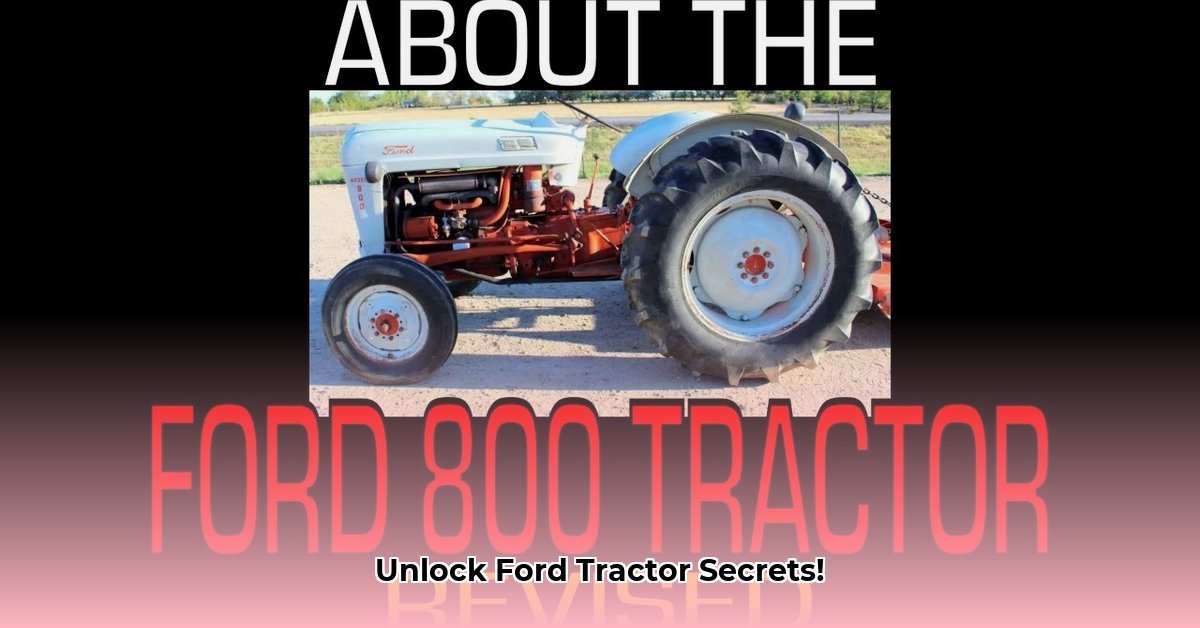
800 Ford Tractor Data: A Deep Dive into a Farming Icon
The Ford 800 tractor—a name synonymous with post-war agricultural progress—holds a significant place in farming history. Manufactured between 1954 and 1957, its production soared from a few units in 1954 to over 116,000 by 1957, a testament to its popularity and effectiveness. This comprehensive guide unlocks the secrets of the Ford 800, exploring its design, capabilities, and enduring legacy. We'll delve into its technical specifications, common issues, and restoration strategies, offering valuable insights for collectors, historians, and enthusiasts. Did you know that the Ford 800's design directly influenced subsequent models, highlighting its impactful design?
Power Under the Hood: More Than Just Horsepower
The Ford 800, while not a speedster, possessed robust power for its time. Its four-cylinder engine, offered in gasoline or LP gas configurations, delivered 35 to 40 horsepower—a respectable output for its era. This was sufficient for most common agricultural tasks. However, its five-speed transmission, lacking synchronized gears, demanded a skillful touch. The absence of power steering added to the physical demands of operation, making it a machine that rewarded its operator with a true connection to the work. "The Ford 800 wasn't about luxury," explains Dr. Amelia Hernandez, Agricultural Historian at the National Museum of Agriculture, "it was about reliable power in a straightforward design that was widely understood." This blend of raw power and rugged simplicity ensured its wide adoption.
More Than Just Muscle: Hydraulics and Beyond
The Ford 800's capabilities extended beyond raw power. Its advanced (for its time) hydraulic system featured both position and draft control, allowing for precise management of implements. This functionality significantly enhanced efficiency in the field. While lacking modern conveniences, the tractor's design cleverly balanced innovation with the practical realities of the era. The incorporation of these hydraulic improvements demonstrates a forward-thinking approach in Ford's engineering.
A Legacy That Endures: The 800’s Long Shadow
The Ford 800's influence stretches far beyond its production years. Its design served as a foundational blueprint for subsequent models, including the 801, 841, and 851, showcasing the success of its initial design and Ford's commitment to iterative improvement. The widespread availability of original manuals and repair guides further solidifies its legacy, making restoration projects feasible for enthusiasts today. The sheer volume of tractors produced, coupled with the resourceful availability of documentation, firmly positions the Ford 800 as a symbol of enduring impact on agricultural technology. This historical significance makes it an attractive subject for study and preservation.
How to Restore a Ford 800 Series Tractor
Key Takeaways:
- Ford 800 restoration requires substantial time and financial resources.
- Two core approaches exist: a meticulous "factory-floor" restoration or a more practical functional restoration.
- Sourcing parts presents a significant challenge, necessitating creative problem-solving and community engagement.
- Thorough planning and realistic budgeting are crucial for project success.
- Prioritizing safety throughout the process is paramount.
Understanding Your Ford 800: A Starting Point
Before embarking on restoration, meticulously document your tractor's current condition. Comprehensive photography and videography are essential for tracking progress and informing restoration strategies. Determine the tractor's completeness—from a "basket case" to a mostly intact machine—to accurately assess parts sourcing needs and project scope. A well-preserved parts manual is invaluable; it serves as your comprehensive guide throughout the process.
Choosing Your Restoration Path: Full vs. Functional
Two contrasting philosophies guide Ford 800 restoration:
Factory-Floor Restoration: This approach aims for a pristine, showroom-ready condition, replicating the original specifications as closely as possible. This method is highly resource-intensive, demanding considerable time and expense.
Functional Restoration: This prioritizes operational functionality over pristine aesthetics. While aiming for original parts, it accepts compromises where necessary, offering a balanced approach.
The optimal path depends on your budget, available time, and mechanical skills.
Sourcing Parts: The Restoration's Biggest Hurdle
Locating parts for a vintage Ford 800 demands resourcefulness. Online forums, specialized vintage tractor parts suppliers, and even scrapyards become valuable resources. Actively engaging with the vintage tractor community is crucial for discovering rare parts and connecting with experienced restorers. The use of reproduction parts may be necessary; conduct thorough research to ensure quality and authenticity.
Disassembly, Cleaning, and Assessment
After procuring parts, begin the meticulous disassembly process. Thorough labeling and photography are critical for organization and reassembly. Subsequently, clean each component thoroughly to assess the extent of damage and necessary repairs or replacements. This detailed examination provides a clear understanding of the restoration's scope.
The Restoration Process: Step-by-Step
- Engine Overhaul: (If needed) This could require professional assistance.
- Transmission and Drivetrain: Assess and restore or replace components as needed.
- Hydraulic System: Flush and inspect; replace malfunctioning elements.
- Electrical System: Address wiring, lights, and the starter motor.
- Bodywork and Paint: Thoroughly remove rust; repair and repaint for structural integrity and aesthetics.
- Reassembly: Carefully follow your parts manual; proceed methodically.
- Testing and Fine-Tuning: Thoroughly test all systems before completion.
Budgeting and Time Management
Restoration costs are highly variable. Construct a detailed budget, encompassing parts, tools, and professional services. Establish realistic timelines, acknowledging the significant time commitment required. Celebrate milestones to maintain project momentum.
Safety First!
Working with vintage machinery demands adherence to safety protocols. Always utilize appropriate personal protective equipment (PPE). Consult your Ford 800's manual for specific safety instructions. Seek professional assistance for tasks beyond your skillset.